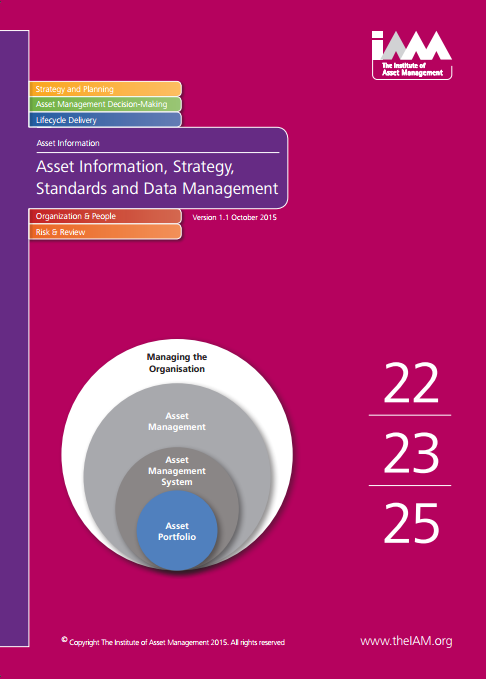Subjects 22, 23 and 25: Asset Information, Strategy, Standards and Data Management
Version 1.1 October 2015
Asset Information, Strategy, Standards and Data Management responds to demand from industry for guidance to carry out better management of asset information. It is applicable to any organisation where physical assets are a key or critical factor in achieving its business objective and in achieving effective service delivery.
Asset information is a combination of data about physical assets used to inform decisions about how they are managed, both for short-term operational purposes and or long-term strategic planning.
The intended audience is the community of people responsible for the management and utilisation of information associated with assets. This group typically includes Asset Management, Engineering, Operations, Finance, and IT departments. However, it also recognises that the understanding of asset information management in an asset management context is an emerging discipline and it is therefore written to allow ‘non-practitioners’ to better understand the key features of good practice asset information management.
With thanks to our sponsors of this publication.
| CONTENTS | |
|---|---|
| Acknowledgements | ii |
| 1 INTRODUCTION TO SUBJECT SPECIFIC GUIDELINES 1.1 Purpose of the SSGs 1.2 The SSGs in context 1.3 SSGs and the issue of Complexity versus Maturity 1.4 Further reading |
6 |
| 2 INTRODUCTION TO THE ASSET INFORMATION SSG 2.1 How to use this SSG 2.2 What is Asset Information? 2.3 Asset Information Systems 2.4 Value of Asset Information 2.5 Scope and Boundaries 2.6 Target Sectors 2.7 Target audience 2.8 Definitions 2.9 Data Quality 2.10 Key Messages |
8 8 9 10 10 12 12 12 13 13 13 |
| 3 GOOD PRACTICE APPROACH FOR ASSET INFORMATION MANAGEMENT 3.1 Purpose and Structure 3.2 Good practice approaches 3.3 Key Messages |
14 14 14 17 |
| 4 THE ASSET INFORMATION MANAGEMENT SYSTEM 4.1 Assess and manage risks 4.2 Collect or acquire information 4.3 Receive, use, transmit and transform information 4.4 Maintain information 4.5 Comply with legal and other requirements 4.6 Manage change 4.7 Archival, retention and disposal of information 4.8 Periodic Review and improvement of the information management system 4.9 Key Messages |
18 18 18 18 18 20 20 20 20 20 |
| 5 GOVERNANCE 5.1 Governance Processes 5.2 Meta-information 5.3 Responsibilities 5.4 Key Messages |
22 22 25 25 25 |
| 6 ASSET INFORMATION STRATEGY 6.1 What is an Asset Information Strategy? 6.2 Why does an organisation need an Asset Information Strategy? 6.3 Developing and Agreeing an Asset Information Strategy 6.4 Implementing the Asset Information Strategy 6.5 Updating the Asset Information Strategy 6.6 Key Messages |
28 |
| 7 STANDARDS, SPECIFICATIONS AND REQUIREMENTS 7.1 Why is Asset Information needed? 7.2 What Asset Information is needed? 7.3 Considerations during requirements gathering 7.4 The Asset Data Dictionary 7.5 Key Messages |
30 |
| 8 INFORMATION LIFE CYCLE 8.1 Assess data 8.2 Improve data 8.3 Store data 8.4 Utilise data 8.5 Acquire new data 8.6 Archive data 8.7 Delete data 8.8 Sustain data quality 8.9 Key Messages |
34 34 38 45 46 50 51 51 52 52 |
| 9 MONITORING 9.1 Data quality measures 9.2 Targets 9.3 Compliance 9.4 Presentation of Measures 9.5 Key Messages |
54 54 54 55 55 55 |
| 10 AUDIT AND AUDIENCE 10.1 Audit 10.2 Assurance 10.3 Key Messages |
56 56 57 57 |
| 11 BENCHMARKING 11.1 Why benchmark? 11.2 Benchmarking and change 11.3 What is ‘Good Practice’? 11.4 Assessment guidelines and maturity modelling 11.5 Alignment with the IAM Self-Assessment Methodology Plus (SAM+) 11.6 Asset Information Subjects for assessment 11.7 Key Messages |
58 |
| 12 THE ORGANISATION AND THE PEOPLE DIMENSION 12.1 People 12.2 Key Messages |
64 64 67 |
| 13 PROCESS 13.1 Key Messages |
68 68 |
| 14 SOFTWARE 14.1 Getting the best from information technology 14.2 Enterprise Architecture 14.3 Information Architecture and the Data Dictionary 14.4 Data Mastering Strategy 14.5 The role of information technology in projects 14.6 Key Messages |
70 70 71 71 72 74 76 |
| 15 MANAGING CHANGE 15.1 Introduction 15.2 What is to change 15.3 Technology Considerations 15.4 Assessing Options and creating a Business Case 15.5 Preparing for the Change Programme 15.6 Programme Management 15.7 Creating the new Processes and Systems 15.8 Commissioning and changes to Processes and Systems 15.9 Culture Change and Change Management 15.10 Key Messages |
78 |
| 16 GLOSSARY OF TERMS | 84 |
| 17 FURTHER READING 17.1 Bibliography 17.2 Publications 17.3 Useful web sites |
86 |

















